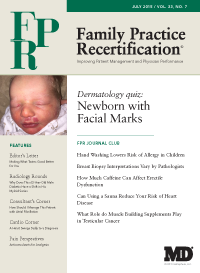Publication
Article
Family Practice Recertification
Breast Biopsy Interpretations Vary by Pathologists
Author(s):
This trial was designed to determine if pathologists can uniformly interpret breast biopsies and found them to be inconsistent approximately 25% of the time.
Review
Diagnostic Concordance Among Pathologists Interpreting Breast Biopsy Specimens JAMA. 2015; 313(11):1122-1132.]
Study Methods
Using a set of known breast biopsy results (including 23 cases of invasive breast cancer, 73 cases of ductal carcinoma in situ (DCIS), 72 cases with atypical hyperplasia (also called atypia), and 72 benign cases), researchers compared individual pathologist interpretations to a standardized consensus panel of physicians. In total, 240 biopsies were used with each pathologist being asked to interpret 60 of them. Participants were blinded to the interpretation of the other pathologists in the study as well as the consensus panel members.
Results
Compared with the consensus panel’s reference diagnosis of these samples, the overall concordance rate of diagnostic interpretations of the studied pathologists was 75.3% (95% CI, 73.4%-77.0%). Disagreement with the reference consensus panel was more common among women with higher breast density (younger women) compared to lower breast density on mammogram (overall concordance rate 73% for higher density vs. 77% for lower density, p < 0.001). Pathologists who interpreted low weekly case volumes or worked in smaller practices or non-academic settings also had higher discordance rates.
The condition where the discordance was greatest was for the diagnosis of atypia with a 35% under interpretation rate and a 17% over interpretation rate. DCIS also had a relatively high under-interpretation of 13% vs. 3% over-interpretation rate. Invasive carcinoma had an under-interpretation rate of about 4%, but had the highest overall concordance rate with the consensus panel.
Conclusion
Overall agreement between individual pathologists and expert consensus driven reference diagnosis was about 75% with the highest concordance rates for invasive carcinoma and the lowest concordance rates for DCIS and atypia.
Discussion
This unique attempt to determine the efficacy of subjective biopsy interpretation by pathologists is somewhat reassuring and may propose further quality improvement processes going forward. It is encouraging the concordance rates were highest for invasive carcinoma, yet there remained a 4% under diagnosis rate. This likely implies that when cancer is overtly present, an individual pathologist can identify it and bring it forward for therapeutic intervention.
What is also concerning is the concordance rate for atypia was 52% (under plus over diagnosis). While this is concerning from a laboratory perspective, the pathophysiology of breast atypia does not imply conversion or evolution into illness or disease, so the ability for it to be under-interpreted 35% of the time (as was found in this study) may not be as clinically significant as the over diagnosis rate.
The concordance rate for DCIS was 84% with under-interpretation at 13% and over-interpretation at 3%. DCIS continues to be a diagnosis for which we have unclear understanding of its natural history and the long term benefit of aggressive treatment. Because of this lack of clarity, the under-interpretation may ultimately be beneficial to patients.
There are approximately 1.6 million breast biopsies occurring in the United States every year. The vast majority of these demonstrate benign disease. When we speak to patients concerning mammographic screening and the subsequent disposition of abnormal mammograms, the concept of over-diagnosis is raised in our minds, and remains confusing to both those in practice as well as patients. This study helps explain why atypia and DCIS are often part of the over-diagnosis problem.
What is Over-Diagnosis? The concept of over-diagnosis in medicine is one where the diagnosis of a known condition occurs when it is unlikely to cause symptoms or shorten a patient’s lifespan. Breast cancer screening has long been accused of over-diagnosis because of mammography’s low positive predictive value. An abnormal mammogram requires further testing via further imaging via ultrasound, more mammograms, or MRI, or an invasive procedure, like stereotactic or excisional biopsy. These all can result in morbidity and mortality, with subsequent physical scarring that could go on to lead to future abnormal imaging and greater need for interventions like biopsies. The morbidity of the emotional scarring and insurance “flagging” remain to be quantified.
Family physicians should use this data to recognize how breast biopsies, especially those demonstrating atypia or DCIS, should be discussed at length with patients. Consideration of an abnormal mammogram should be made for consultation with a understanding and conservative surgeon. Pathologists should heed this study as a call to find ways to improve their diagnostic methods. And most importantly, all parties: PCP’s, mammography “centers” and public media should continue to focus on patient-centered outcomes with regard to recruitment for mammography screening (current guidelines remain to start screening at 50). Aggressive interpretation, sometimes lead by the concern of a missed diagnosis and resulting lawsuite, will likely lead to increased utilization of resources, increased costs, and increased surgical intervention. In the areas where there was the greatest discordance (atypia and DCIS), this can lead to significant morbidity and mortality on its own.




